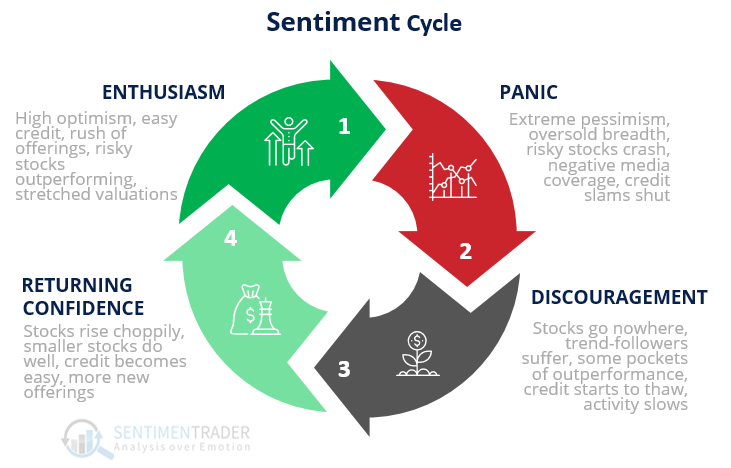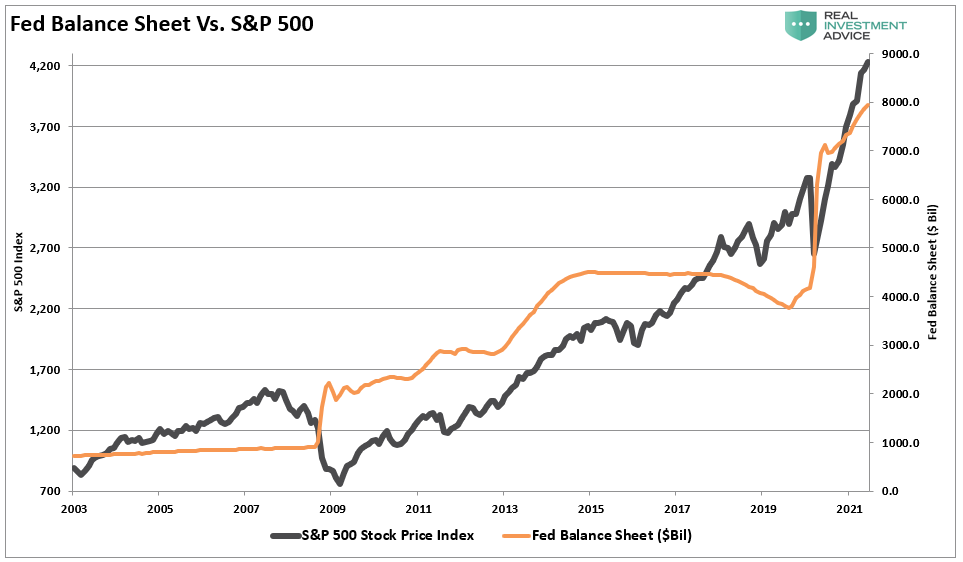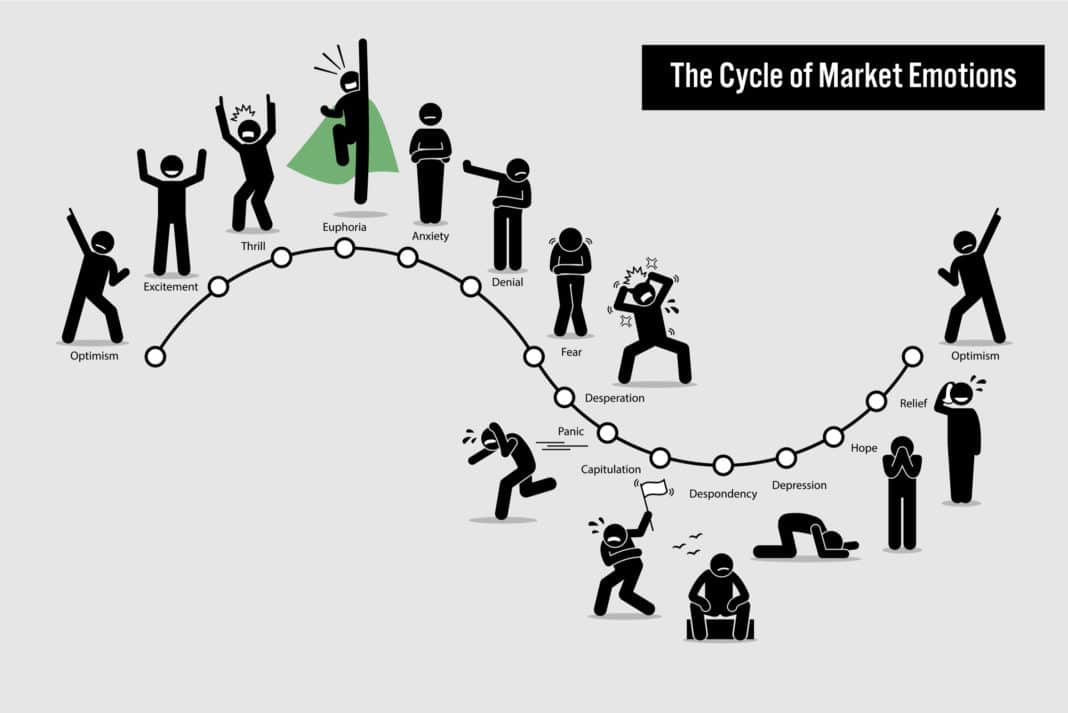Do you think you may have a stock market addiction? In this article, we’re going to talk about how to recognize the signs, why it’s potentially destructive, and what you can do if you believe you may be addicted to trading.
Why Is The Stock Market So Addictive?
A few years ago, I discussed the issue of a trading addiction as we saw early signs of speculative excess at the time. However, we had no idea the degree to which we would see those excesses grow. As Sentiment Trader noted:
“This type of market activity is an indication that markets have returned their ‘enthusiasm’ stage. Such is characterized by:
- High optimism
- Easy credit (too easy, with loose terms)
- A rush of initial and secondary offerings
- Risky stocks outperforming
- Stretched valuations”

Addiction is the inability to stop consuming a chemical or pursuing an activity despite causing harm.
What is stock market addiction? There is a thin line between being passionate about investing and losing the ability to stop trading. When it crosses that line, you have a stock market addiction.
Addictions come in various ways, from alcohol to drugs, coffee, porn, sex, gambling, work, spending, devices, and social media. However, each of these “addictions” has a shared physical and psychological trait.
“Most disease and hardship for our species has been a function of scarcity from too little salt, sugar, fat, approval, safety, or opportunities to mate. As a result, when we find these things, our brain produces the ultimate reward, the pleasure hormone ‘dopamine.'”
Why is the stock market so addictive? For the same reason as other things are addictive – “dopamine.” Dopamine reinforces a kind of training process by your brain. You get rewarded for certain activities, so you learn to do them passionately. Therefore, it is hard to retrain and go into reverse, even if your life and financial solvency depend on it.
Such is why gamblers in Las Vegas will stay at the table until the “house always wins.” Games of chance get designed to tap into this psychological response for profit. The same is true with social media and trading apps. For example, the trading app “Robinhood (NASDAQ:HOOD)” recently removed the “confetti” for completing a “successful trade” due to a rash of criticisms. Why? Because it creates the same “dopamine” effect as the flashing lights on a slot machine or getting “likes” on your social media posts.
Can You Actually Get Addicted To The Stock Market
Just recently, Brian Bloch penned an interesting piece for Investopedia:
“Trading in the financial markets is stimulating, exciting, and engrossing. But you can become addicted, just like with actual casino gambling or using illicit drugs. Like any severe addiction, trading addiction can cost you socially and economically.
The problem focuses on the brain and understanding how its reward systems can train you to trade compulsively and dangerously.”
Yes, can you be addicted to the stock market? As with any vice, once an individual becomes addicted, they begin to exhibit similar destructive behaviors. However, the first time an individual uses an illicit drug, there are no immediate negative consequences from the engagement. Therefore, they assume “they are different” than others and have control over their actions.
The same holds with speculative investing. As we discussed in “Pavlov’s Dogs,“ young investors have been trained to respond to the Fed’s “ringing of the bell.” To wit:
“Importantly, for conditioning to work, the ‘neutral stimulus,’ when introduced, must be followed by the ‘potent stimulus,’ for the ‘pairing’ to be completed. For investors, as each round of ‘Quantitative Easing’ was introduced, the ‘neutral stimulus,’ the stock market rose, the ‘potent stimulus.’”

More than 12-years, and 400% in gains later, the “pairing” is complete.
Fortunately, some tell-tale signs should alert you, your family, or friends to a genuine problem and danger.
How Do You Know When To Stop Trading?
The first step in overcoming a stock market addiction is recognizing you have one. Here are some signs that will allow you to know when to stop trading.
- You spend far too much of your free time trading.
- You are trading stocks at work (and it isn’t your job)
- The “high” of trying to find the next “moonshot” is the focus of attention.
- You have feelings for frustration, aggression or attempt to suppress other personal problems.
- Losing money on a position makes you depressed.
- You can’t stop trading.
- Continually looking at your phone to check the latest value.
- You lie to others about what you are doing on your phone.
- The bulk of your investing advice comes from social media “experts.”
- You borrowed money on a credit card, home equity line, or a personal loan to invest.
- Your emotional state is directly tied to the outcome of the stock market.
- There is a lack of self-control or ability to stay away from your trading app.
- You spend more time thinking about your portfolio than socializing with friends.
- You are in the process of, or already have, ruined a personal relationship.
These are telltale signs of an addiction.
As with any addiction, the outcomes are never positive.
Currently, individuals addicted to trading are engaging in the most disastrous behaviors, from chasing highly speculative stocks to piling into options, taking on leverage, and tapping credit lines to fuel their habits.
You Could Potentially Lose Everything
Robinhood’s company’s mission to “democratize finance for all,” is similar to Pablo Escobar saying his mission was to “democratize cocaine.” – Scott Galloway
Once an individual gets addicted, there is a commonality of behavioral patterns that induce a self-perpetuating disaster. Unfortunately, when it comes to the stock market, the traits are the same.
- Initially, things go well and “fast money” leads individuals into believing they know what they are doing.
- They then begin developing “confirmation bias” by seeking out information via social media, friends, family or the internet that supports their views.
- They continue to take on more risk and even leverage in their efforts to “bet” more in the efforts to “make a fortune.”
- As is always the case, these initial successes are “beginner’s luck.”
- Eventually, the losses will begin to mount.
- Individuals then “double down” to try and “win back” their losses by taking on even more “risky” investments.
- As the losses accelerate, they start taking on more leverage (tapping credit cards, home equity, etc.) to “stay in the game.”
- Eventually, the losses become so great individuals eventually fall into the “despair” and is usually the point where they liquidate what little they may have left. (Unfortunately, the personal debt remains.)
Interestingly this is the very definition of the psychological investing cycle. (Chart courtesy of Money Crashers)

“If there is an innate psychological tendency toward compulsion and addiction, the initially harmless (cheap) thrills can turn into an obsessive desire to repeat and prolong the pleasure. However, just as heroin addicts reputedly spend most of their junkie careers chasing unsuccessfully after the incredible high of the first time, so too it is with trading addicts.” – Brian Bloch
How Do I Stop Trading?
“I don’t have a problem. I can stop any time I choose to.” – said by every addict ever.
The first step in solving any addiction is admitting that you have a problem. Such isn’t easy in the midst of a raging “bull market” as you are still in the midst of the “high.” However, a careful and objective evaluation of your actions and investing habits can help you identify the problem before the eventual destructive outcome.
Once you can admit that you may have a problem, you can begin to take corrective actions. Here are ways that you can start to control your stock market addiction and stop trading:
- Hire a fiduciary advisor to take over your investment account.
- Remove the “trading apps” from your phone.
- Turn off and unfollow “financial” social media and financial television. (Stop feeding the beast).
- Talk about your issues with family and trusted friends.
- Seek out addiction and counseling centers which have a specialty in “retraining” your brain.
Once you have taken a break and can become “objective,” you can begin to rebuild your “investment” strategy. First, work with your advisor to develop a sound investment discipline and strategy that reduces portfolio risk and minimizes trading activity. Then, as you gain confidence in a controlled strategy, you can monitor your actions and remain prudent. At that point, you are ready to take back control of your portfolio.
However, it is essential to remember that you are never “cured” of an addiction. You only learn to control it healthily.
In 1999, an entire generation was devastated by the “Dot.com” crash. In 2008, it happened again. The next crash will wipe out many of the “Gen-Z” investors in the market today. It will happen; it is only a function of time until it occurs.
Make sure that you aren’t one of its next victims.
